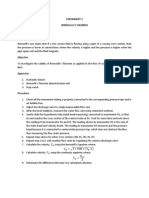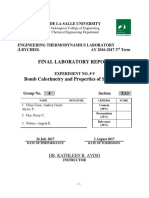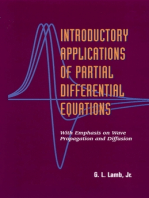LS5 - Heat Conduction (Simple Bar)
Uploaded by
Faez FeakryLS5 - Heat Conduction (Simple Bar)
Uploaded by
Faez FeakryThermalfluids Lab-MEC 554/ LS 5/ THOMAS Rev.
01-2007
UNIVERSITI TEKNOLOGI MARA
FACULTY OF MECHANICAL ENGINEERING
________________________________________________________________________
Program
Course
Code
:
:
:
LAB SHEET NO :
Bachelor Of Engineering ( Hons ) Mechanical
Thermalfluids Lab
MEC 554
5
HEAT TRANSFER LABORATORY SHEET
TITLE : HEAT CONDUCTION SIMPLE BAR
1.
OBJECTIVE
Investigate Fouriers law for linear conduction of heat along a simple bar.
2.
THEORY
If a plane wall of thickness (x) and area (A) and thermal
conductivity (k) supports a temperature difference (T) then the
heat transfer rate by conduction is given by the equation:
dT
Q k A
dx
Assuming a constant thermal conductivity throughout the
material and a linear temperature distribution, this is:
T
Q k A
x
Thermalfluids Lab-MEC 554/ LS 5/ THOMAS Rev. 01-2007
3.
EQUIPMENT
The equipment is shown in the figure below.
4.
READINGS TO BE TAKEN
Select an intermediate position for the heater power control (e.g. 10 W) and allow sufficient time for
a steady state to be achieved before recording the temperature (T) at all 9 sensor points and the
input power reading on the wattmeter ( Q ). This procedure should be repeated for other input
powers (e.g. 20 W and 30W) up to the maximum setting of the control. After each change, sufficient
time must be allowed to achieve steady conditions.
5.
RESULTS
BRASS
SAMPLE REGION
HEATER
COOLER
x (mm)
10
20
30
40
50
60
70
80
x (m)
0.01
0.02
0.03
0.04
0.05
0.06
0.07
0.08
Test
T1
T2
T3
T4
T5
T6
T7
T8
T9
(W)
(C)
(C)
(C)
(C)
(C)
(C)
(C)
(C)
(C)
A
B
C
Thermalfluids Lab-MEC 554/ LS 5/ THOMAS Rev. 01-2007
1.
Plot the temperature profile along the entire length. This should reveal three distinct
sections of straight lines (corresponding to the heater, brass sample, and cooler) having
a slope of approximately T/x.
2.
Convert the measured temperatures to degrees Kelvin by the following formula:
T K T C 273.15
3.
Calculate the cross-sectional area (A) of the circular cylinder by using the equation:
A
4.
d2
The brass sample region is the region of interest. Ignore all other temperature
measurements except T4, T5, and T6 and calculate the thermal conductivity of the
brass. This is the slope of the straight line in the brass sample region alone (plotted in
1), given by the equation:
5.
Q x
A T
W
units
m K
Find published values of brass in books or on the Internet. Compare the value you
obtained with these values. Which type of brass does your results best compare with
(e.g. yellow brass, red brass etc.)? Discuss any source of error in your measured
results. Students should comment on how changing the average temperature affects
the thermal conductivity.
You might also like
- Experiment No. 4 Forced Convection Heat Transfer From A Flat Plate To Air 1No ratings yetExperiment No. 4 Forced Convection Heat Transfer From A Flat Plate To Air 13 pages
- Experiment #3: Fourier'S Law: The Effects of Varying Cross-Sectional AreaNo ratings yetExperiment #3: Fourier'S Law: The Effects of Varying Cross-Sectional Area5 pages
- MAK 302L Experiment 3 Extended Surface Heat Transfer 1. PurposeNo ratings yetMAK 302L Experiment 3 Extended Surface Heat Transfer 1. Purpose5 pages
- Thermal Conductivity Apparatus: (Two Slab Guarded Hot Plate Method)No ratings yetThermal Conductivity Apparatus: (Two Slab Guarded Hot Plate Method)8 pages
- Free/Force Convection H.T From Pinned&finnedNo ratings yetFree/Force Convection H.T From Pinned&finned14 pages
- Combined Convection and Radiation Mechanical Engineering ThermoNo ratings yetCombined Convection and Radiation Mechanical Engineering Thermo15 pages
- Air Flow Velocity and Pressure Coefficient Around The 90o Rectangular Duct (Fluid Exp 5)No ratings yetAir Flow Velocity and Pressure Coefficient Around The 90o Rectangular Duct (Fluid Exp 5)9 pages
- Final Laboratory Report: de La Salle UniversityNo ratings yetFinal Laboratory Report: de La Salle University15 pages
- LAB14 MARCET BOILER (Abstract, Intro, Aim, Theory)No ratings yetLAB14 MARCET BOILER (Abstract, Intro, Aim, Theory)3 pages
- Experiment 2 - Forced Draft Cooling TowerNo ratings yetExperiment 2 - Forced Draft Cooling Tower14 pages
- Measuring The Thermal Conductivity of CopperNo ratings yetMeasuring The Thermal Conductivity of Copper4 pages
- Experiment - 2 Thermal Conductivity of LiquidNo ratings yetExperiment - 2 Thermal Conductivity of Liquid3 pages
- Natural Convection Manual - 220902 - 120419No ratings yetNatural Convection Manual - 220902 - 1204196 pages
- Introductory Applications of Partial Differential Equations: With Emphasis on Wave Propagation and DiffusionFrom EverandIntroductory Applications of Partial Differential Equations: With Emphasis on Wave Propagation and DiffusionNo ratings yet
- G1 - Mohamad Taslin Shah - 1001748107 - Exp 6No ratings yetG1 - Mohamad Taslin Shah - 1001748107 - Exp 624 pages
- Application of Internship Placement For Engineering StudentNo ratings yetApplication of Internship Placement For Engineering Student1 page
- Universiti Teknologi Mara (Uitm) Shah AlamNo ratings yetUniversiti Teknologi Mara (Uitm) Shah Alam1 page
- Topic 1: Introduction To Control System and Mathematical ReviewNo ratings yetTopic 1: Introduction To Control System and Mathematical Review43 pages
- Mem575 Industrial Management Course Outline PM IsmailNo ratings yetMem575 Industrial Management Course Outline PM Ismail8 pages
- Mem575 Industrial Management Course Outline PM IsmailNo ratings yetMem575 Industrial Management Course Outline PM Ismail8 pages
- 10.0 References: Micro-And Nano-Metrology". Meas. Sci. Technol. 17, 504-509No ratings yet10.0 References: Micro-And Nano-Metrology". Meas. Sci. Technol. 17, 504-5091 page
- LS2 - Variation in Refrigeration Coefficient of Performance at Various Operating Conditions50% (2)LS2 - Variation in Refrigeration Coefficient of Performance at Various Operating Conditions7 pages
- 5.0 Method of Approach Sand and Mold PreparationNo ratings yet5.0 Method of Approach Sand and Mold Preparation6 pages
- Results and Data Analysis: 2 Cups of Pallets Cup + Pallets 0.116 KGNo ratings yetResults and Data Analysis: 2 Cups of Pallets Cup + Pallets 0.116 KG2 pages













































































